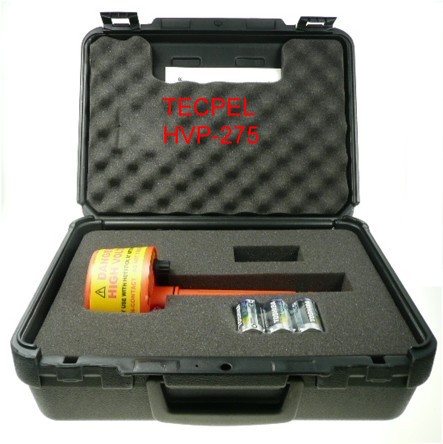Introduction: The TECPEL HVP-275 is a high voltage proximity detector.
It has eight voltage detection settings from 240Vac to
275kVac. The HVP-275 consists of an internal pickup
sensor plate, a sensitivity selector, a visual and a
sound annunciator. With the HVP-275, physical contact
with electrical conductors is not necessary when
testing for live lines. This tester works by proximity.
Its sensor senses the radiated field which surrounds
live conductors. Radiated field strength increases
with voltage and decreases quickly with distance or
earth shielding. The radiated field from a cable of
closely bunched conductors supplied by three phase
power tends to cancel (See “Limitations of use”
paragraph). Detecting distance of a 250Vac single
live wire is approximately 10cm. With a bunched
neutral and earth cable, as in a flexible cable, the
distance is reduced to 5cm.
Some of the typical uses are : identify and check live
cables; find fault in flexible cables; check earth
equipment; service neon lightning; trace live wires;
check high frequency radiation; detect residual or
induced voltages. For example, faults in damaged
flexible cables are found by applying low voltage to
each conductor. Earthing the remainder and moving
the tester along the cable until the change in condition
is obtained. (Flexible cables which are used in mining
and building industries, are readily repairable when
the break in the cable is located.)
When testing for high voltage, the rotary switch
(attenuator) is used to identify and differentiate
various HV live cables. The tester must be used in
conjunction with a long and insulating rod when
measuring high voltage (kV). However, the HVP-275 is
a non-contact tester and it is advised that the tester
should never come into contact with cables (kV) as
this tester is merely a non-contact AC proximity tester.
Checking or proofing the tester is easy. Switch the
sensitivity to 240V and place the dome against a low
voltage live conductor or rub the dome with a cloth or
against an item of clothing as this generates a static
DC which triggers the detection of circuit. The light
and beeper should go “on” as if a live wire is being approached. Approaching the dome near a computer screen or a TV screen should also trigger
the tester while on the 240V selection. The power consumption of the 275HP is very low, and the
tester should always be tested as described above before using it.
Specifications: Expected test results ( laboratory testing ) :
Range
240V
2kV
6kV
11kV
22kV
33kV
132kV
275kV
Typical observation of test results made in the field :
Range
11kV
22kV
33kV
132kV
275kV
Operated from
Variable from 80V
or depending on the type of source
250V
500V
1000V
1500V
4000V
8000V
22kV
Min. Detection MDV as % of
Voltage (MDV) Line Voltage
1kV 9.1%
2kV 9.1%
3.1kV 9.4%
12.5kV 9.5%
22.5kV 8.2%
Limitation of usage. Limitations of use :
It is recommended that the HVP-275 is not used in HV yards of mixed voltages.
In the presence of mixed voltages, the tester can become unreliable.
Problems can arise when the tertiary circuit of a 275/133/11kV transformer is
tested. The electric field of the HV and MV bus bars can trigger the detector when
it is about 3m above the ground. This is common with most of the electric field
voltage detectors, and the users should be aware of it. The tester can pick up
adjacent circuit to the one being tested and indicate the wrong information to the
user. Limitations of use :
It is recommended that the HVP-275 is not used in HV yards of mixed voltages.
In the presence of mixed voltages, the tester can become unreliable.
Problems can arise when the tertiary circuit of a 275/133/11kV transformer is
tested. The electric field of the HV and MV bus bars can trigger the detector when
it is about 3m above the ground. This is common with most of the electric field
voltage detectors, and the users should be aware of it. The tester can pick up
adjacent circuit to the one being tested and indicate the wrong information to the
user.
Q & A for High Voltage Proximity Detector ( HVP-275) :
1. Could it detect 220v and maybe 10KV unshielded aerial cable ?
As long as the unshielded aerial cable has AC voltage, it generates electric field.
So that the HVP-275 can detect the AC voltage.
HVP-275 can detect 220V cable and 10kV cable, users can select the range they need to do the test.
2.. May I ask sensitivity for each setting ?
About the sensitivity, The distance can be a reference answer for the sensitivity.
See the attached Test Report
3. HVP-275 has many ranges for testing.
If the customer test 24kV, they should choose lower ranges to detect.
Such as 22kV, 11kV, 6kV, 2kV....
The lower the voltage setting, the longer the distance.
If they select higher ranges, of course the detection distance is short
4. My customer used HVP-275 with 24 kV overhead XLPE cable but it seems does not work. He must almost touch the detector with the cable then ther detector will work.
In case of they want to detect the voltage by touching the detector with the live part or cable, should they use this method?
Is it safe for touching the detector with the live part ? I wonder if the the detoctor could be damaged.
Answer:
If the high voltage cable has ground shielding. The customer can not use HVP-275 to detect the high voltages.
Because the electric filed can not be generated, then HVP-275 can not detect the electric filed of the high voltage.
HVP-275 is non-contact type detector, so it can not touch the detector with the live part or cable.
Download Manual of High Voltage Proximity tester
See more Electric Testers



